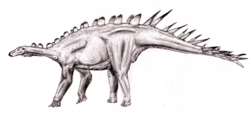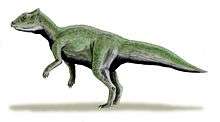Oxfordian (stage)
| System/ Period |
Series/ Epoch |
Stage/ Age |
Age (Ma) | |
|---|---|---|---|---|
| Cretaceous | Lower/ Early |
Berriasian | younger | |
| Jurassic | Upper/ Late |
Tithonian | ~145.0 | 152.1 |
| Kimmeridgian | 152.1 | 157.3 | ||
| Oxfordian | 157.3 | 163.5 | ||
| Middle | Callovian | 163.5 | 166.1 | |
| Bathonian | 166.1 | 168.3 | ||
| Bajocian | 168.3 | 170.3 | ||
| Aalenian | 170.3 | 174.1 | ||
| Lower/ Early |
Toarcian | 174.1 | 182.7 | |
| Pliensbachian | 182.7 | 190.8 | ||
| Sinemurian | 190.8 | 199.3 | ||
| Hettangian | 199.3 | 201.3 | ||
| Triassic | Upper/ Late |
Rhaetian | older | |
| Subdivision of the Jurassic system according to the ICS, as of 2017.[1] | ||||
The Oxfordian is, in the ICS' geologic timescale, the earliest age of the Late Jurassic epoch, or the lowest stage of the Upper Jurassic series. It spans the time between 163.5 ± 4 Ma and 157.3 ± 4 Ma (million years ago). The Oxfordian is preceded by the Callovian and is followed by the Kimmeridgian.[2]
Stratigraphic definitions
The Oxfordian stage was called "Clunch Clay and Shale" by William Smith (1815–1816); in 1818 W. Buckland described them under the unwieldy title "Oxford, Forest or Fen Clay". The term Oxfordian was introduced by Alcide d'Orbigny in 1844. The name is derived from the English county of Oxford,[3] where the beds are well developed, but they crop out almost continuously from Dorsetshire to the coast of Yorkshire, generally forming low, broad valleys. They are well exposed at Weymouth, Oxford, Bedford, Peterborough, and in the cliffs at Scarborough, Red Cliff and Gristhorpe Bay. Rocks of this age are found also in Uig and Skye.[4]
The base of the Oxfordian stage is defined as the point in the stratigraphic record where the ammonite species Brightia thuouxensis first appears. A global reference profile for the base (a GSSP) had in 2009 not yet been assigned. The top of the Oxfordian stage (the base of the Kimmeridgian) is at the first appearance of ammonite species Pictonia baylei.
In the Tethys domain, the Oxfordian contains six ammonite biozones:
- zone of Epipeltoceras bimammatum
- zone of Perishinctes bifurcatus
- zone of Gregoryceras transversarium
- zone of Perisphinctes plicatilis
- zone of Cardioceras cordatum
- zone of Quenstedtoceras mariae
Palaeontology
†Sauropods
| Sauropods of the Oxfordian | ||||
|---|---|---|---|---|
| Taxa | Presence | Location | Description | Images |
| Bathonian-Oxfordian | Originally thought to have lived form the Hauterivian to Barremian. | |||
†Ornithischians
| Ornithischians of the Oxfordian | ||||
|---|---|---|---|---|
| Taxa | Presence | Location | Description | Images |
| Oxfordian? Tithonian? | Chaoyang, Liaoning, China | A marginocephalian dinosaur from the Late Jurassic of China, belonged to the Ceratopsia, a group of primarily herbivorous dinosaurs with parrot-like beaks |  Chaoyangsaurus  Chialingosaurus  Chungkingosaurus  Dacentrurus  Tuojiangosaurus  Yinlong | |
| Upper Shaximiao Formation, Sichuan, China | A genus of stegosaur similar to Kentrosaurus | |||
| Upper Shaximiao Formation, Sichuan, China | One of the smallest of the stegosaurids at 3–4 metres (9.8–13.1 ft) long, Chungkingosaurus had at least five spikes on its thagomizer. It had a rather high and narrow skull and large, thick bony plates. | |||
| England, France, Spain, Portugal | A large stegosaurid | |||
| Dashanpu Formation, Sichuan, China | By extrapolation from the remains of possible species and other basal ornithopods, it was a herbivorous bipedal animal around 1.3 to 1.5 meters (4.3 to 4.9 ft) long. It would have been a strong runner | |||
| Junggar Basin, Xinjiang, China | A genus of stegosaurid | |||
| Upper Shaximiao Formation, Sichuan, China | The best understood of the Chinese stegosaurs. It was around 7.0 meters (23.0 feet) long and 2 meters (6.6 feet) high, with a postulated weight of around 4 metric tons (4.4 short tons). | |||
| Shishugou Formation, Xinjiang, China | A small, primarily bipedal herbivore, approximately 1.2 meters (3.9 feet) long, the oldest and most primitive ceratopsian known to science. | |||
†Plesiosaurians
| Plesiosaurians of the Oxfordian | ||||
|---|---|---|---|---|
| Taxa | Presence | Location | Description | Images |
| Bajocian-Tithonian | ||||
†Thalattosuchians
| Thalattosuchians of the Oxfordian | ||||
|---|---|---|---|---|
| Taxa | Presence | Location | Description | Images |
 Metriorhynchus, a marine crocodilian. | ||||
| An opportunistic carnivore that fed on fish, belemnites and other marine animals and possible carrion. Metriorhynchus grew to an average adult length of 3 meters (9.8 feet), although some individuals may have reached lengths rivaling those of large nile crocodiles. | ||||
Theropods
| Theropoda of the Oxfordian | ||||
|---|---|---|---|---|
| Taxa | Presence | Location | Description | Images |
| Bathonian-Oxfordian | Originally thought to have lived form the Hauterivian to Barremian. |  Yangchuanosaurus | ||
| Upper Shaximiao Formation, China | Monolophosaurus was a medium-sized predator that grew to at least 5 meters (16 feet) long. It had an odd, unique crest on its head which ran most of the length of the skull. | |||
| France | one of the first dinosaurs collected and was the first described, though not named. | |||
| Upper Shaximiao Formation, Sichuan, China | Yangchuanosaurus shangyouensis reached about 7 meters (23 feet) long with a skull around 80 cm (31 in) long. Its relative Y. magnus grew larger still: up to 10 meters (33 feet) long with a skull up to 1 metre (3.3 feet) in length. There was a bony knob on its nose and multiple hornlets and ridges, similar to Ceratosaurus. It had a massive tail that was about half its length. | |||
Cephalopods
| Cephalopods of the Oxfordian | ||||
|---|---|---|---|---|
| Taxa | Presence | Location | Description | Images |
 Belemnite fossils | ||||
 An illustration of a variety of fossil nautiloids. | ||||
References
Notes
- ↑ http://www.stratigraphy.org/index.php/ics-chart-timescale
- ↑ For a detailed geologic timescale see Gradstein et al. (2004)
- ↑ Oxfordian is a word meaning "from Oxford" (see wiktionary:Oxfordian).
- ↑

Literature
- Brongniart, A.; 1829: Tableau théorique de la succession et de la disposition la plus générale on Europa, des terrains et roches, qui composent l'écorce de la terre, Paris.(in French)
- Gradstein, F.M.; Ogg, J.G. & Smith, A.G.; 2004: A Geologic Time Scale 2004, Cambridge University Press.
External links
- GeoWhen Database - Oxfordian
- Jurassic-Cretaceous timescale, at the website of the subcommission for stratigraphic information of the ICS
- Stratigraphic chart of the Upper Jurassic, at the website of Norges Network of offshore records of geology and stratigraphy